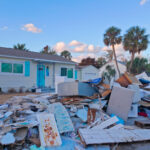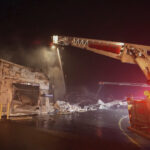Released in late spring 2015, the movie San Andreas tells the story of massive earthquakes devastating California as a helicopter pilot and his (formerly estranged) wife try to find and rescue their daughter. Having defeated the likes of genetically engineered monsters, ancient Egyptian tyrants, and terrorist ninjas in his earlier films, Dwayne “The Rock” Johnson finally meets his match in the shape of those shifting rocks that underlie California.
In its successful first weekend, probably more people watched the movie than the number of Californians who have earthquake insurance. Whether that translates into heightened preparation for future earthquakes is another question. Much of the science in the movie sacrifices credibility for spectacle.
The earthquakes portrayed are catastrophic to the point of potentially reinforcing the notion that there’s no point in preparing. Despite that, there does seem to be some increased thought from the general public about preparation. In the days and weeks following the movie’s release, there was a minor uptick in people googling earthquake insurance — and the California Earthquake Authority (CEA) noted a doubling of hits to its website.
What’s Right
While Hollywood is infamous for not treating its drama with appropriate deference to science, San Andreas actually gets some of the finer points right, including:
• Earthquake Swarm. The beginning of the movie describes an “earthquake swarm” in Nevada — the occurrence of hundreds of smaller earthquakes across a period of a few days. This is a very real phenomenon, though not necessarily a reason for panic. A seismologist would not be as surprised as those in the movie by the occurrence of earthquakes in Nevada.
• Fire Following. The movie correctly emphasizes that an earthquake will likely cause gas pipes to break and fires to break out. This has potential for a major conflagration, as was the case in the 1906 San Francisco earthquake.
• Ongoing Aftershocks. Throughout the movie, the stars are rocked by a regular series of aftershocks. Aftershocks are an often overlooked component of how terrifying an earthquake can be. Survivors of an earthquake often comment on the personal stress and anxiety of experiencing numerous smaller shaking events following the main shock.
What’s Wrong
Of course, that doesn’t mean the writers didn’t take some liberties. Some of the larger inaccuracies presented in the film include:
• The Earth Opening Up Along the San Andreas. Earthquakes are, of course, caused by rocks being pushed together. The two sides of the San Andreas Fault would slide past each other and never pull apart (otherwise there would be no friction to cause the earthquake).
• The “One Wave” Tsunami. A tsunami is made up of multiple inundation waves and is characterized by a series of incoming and receding displacements of water. Proper caution following an initial surge should always be exercised in a tsunami scenario for this very reason.
• The Magnitude 9.6 Earthquake. The magnitude potential for the San Andreas Fault is drastically overstated in the movie. Such an earthquake would require around 12,000 years of build up since the last earthquake; in reality, there has only been about 1 percent of that.
Despite the ever-growing chance of a future earthquake in California, the likely reality of its catastrophe is much more mundane than the scenario painted by the film. However, while the movie presents the disaster as “over” by the end of the film, the real disaster would probably just be beginning in real life. The economic cost of any sizable earthquake in a Californian population center could be staggering, and may take years or decades to recover.
Regardless of what the movie got right and wrong, anything that keeps us talking about the dangers posed to California by earthquakes is welcome. Only about 10 percent of Californian homeowners are covered by insurance against earthquake damage. It’s easier to sell a movie about earthquakes than it is to sell insurance for earthquakes, but there is opportunity for change so long as the dialogue continues.
Bailey is natural hazards specialist (earthquake) at Swiss Re, a wholesale provider of reinsurance and other insurance-based forms of risk transfer.
Topics Catastrophe California
Was this article valuable?
Here are more articles you may enjoy.


 Delta Plane Catches Fire at Orlando Airport in Latest Incident for Airline
Delta Plane Catches Fire at Orlando Airport in Latest Incident for Airline  Class Action Accuses Toyota of Illegally Sharing Drivers’ Data With Progressive
Class Action Accuses Toyota of Illegally Sharing Drivers’ Data With Progressive  More Floridians Moving Out Due to Housing, Insurance Costs, Cotality Report Says
More Floridians Moving Out Due to Housing, Insurance Costs, Cotality Report Says  NJ Wildfire Update: 50% Contained; High Spread Risk Today; Suspect in Custody
NJ Wildfire Update: 50% Contained; High Spread Risk Today; Suspect in Custody 


